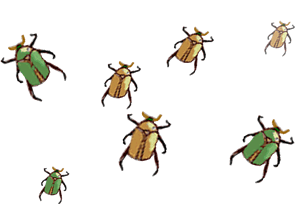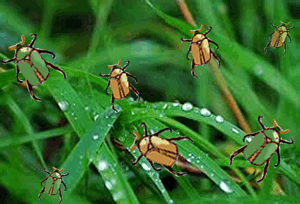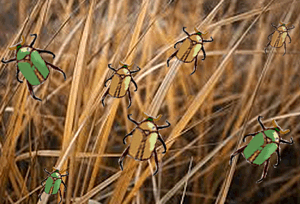Natural selection
(Catch phrase "survival of the fittest" ) |
|
| |
Natural selection, along with mutation, migration and genetic drift, is a key mechanism of evolution.
Darwin's theory of evolution by natural selection is a relatively simple one and can easily be explained by considering a population of beetles. In this population we have brown and green beetles, the difference in colour has occurred through random mutation. Mutation provides genetic variation within a population. |

|
| Now consider a green grass environment. The brown beetles are easily spotted by birds and are eaten, therefore, their rate of reproduction is very low compared to the green beetles. In other words there is differential reproduction between the brown and green beetles. Over time the end result is that the population will come to be dominated by green beetles as heredity dictates the trait for green colour is passed on. |

|
| Now imagine if for several years the area experienced severe drought, the grass would dry up and expose the green beetles to predators. Rate of reproduction for green beetles now would be lower than the brown ones and over time if the drought continued brown beetles would dominate the population. |
 |
| The peppered moth story is a classic example of natural selection, due to environmental change. Peppered moths were dominant with black variants coexisting in small numbers.Then during the industrial revolution the environment started to change.Llight coloured bark of trees in the cities was covered with soot from the burning of coal. The spotted version of the moth was highly visible to birds and preyed upon at a higher frequency than the black variant. The black variant became more dominant as it blended in well in its environment |

|
So if there is variation in the population and differential reproduction occurs through some environmental phenomenon, heredity will ensure beneficial traits are passed on to the next generation. The outcome will be evolution through natural selection. |
| 1) What is meant by the term genetic variation within a population? What is its importance? |
| 2) How does variation come about? |
| 3) What is another term for "Survival of the fittest"? Why is this term inaccurate? |
| 4) Explain, with one example, the term differential reproduction. |
| 5) What role does differential reproduction play in evolution? |
| 6) Explain the role natural selection and geographical isolation play in evolution of new species. This is referred to as allopatric speciation. |
| 7) Research the term genetic drift and give one example and give one example of how genetic drift can influence the gene pool of future generations of a particular species. |
8) Place the following in their correct order for natural selection.
1) Differential reproduction, 2) mutation, 3) heredity, 4) variation.
Solutions |



